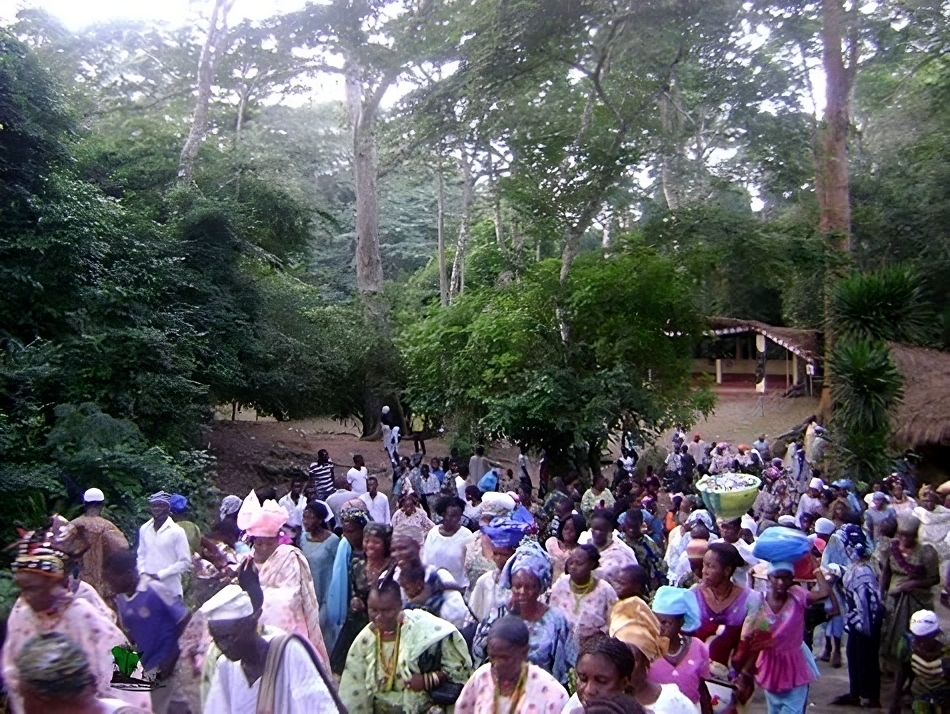Arugba Osun: Cynosure of all Eyes
By Eniola Ola-Samuel
The Osun Osogbo Festival is one of the most attended cultural celebrations in Africa, attracting tourists and osun faithfuls from all parts of the world. One, if not, the most important component of the festival however is the tradition of the Arugba maid, without which the festivals becomes impossible, we take a look at the history and importance of the Arugba.

Every August, Osogbo town plays host to one of the most interesting festivals in the world, the Osun Osogbo Festival. Since the town became host of the country’s second World Heritage site, the gravitation pull of adventurous tourists has become hard to resist. Its a festival that allows tourists to discover the plains, the streams and forest of Osogbo, the land of Oroki, famed for its indigo dye, ‘aro’. The one month long festival is believed to be a covenant between the indigenes and the water goddess, during which time, the indigenes thank the water goddess for the peace, tranquillity and prosperity bestowed on the town by the goddess and also to ask for more favours from the goddess for the next year.
The festival is laced with many cultural displays and commences yearly with the Iwopopo, the traditional cleansing of the town, followed three days later by the lighting of the 500-year-old 16-point lamp called ‘Ina Olojumerindinlogun’. The annual Osun Osogbo festival climaxes with the all important Arugba (votary maid ) ferrying a broad-rimmed calabash to Osun sacred grove followed by the whole town and dignitaries from all over. As the central icon of the festival, she is plainly the attraction for the more than 200,000 visitors who have come all the way to Osogbo.Anyone who had witnessed the festival would understand how exhausting the journey can be, the macabre dance balancing such broad- rimmed calabash and the long walk from the palace to the grove. She is the center of attraction of the entire event, which explained the rationale behind her significance in the festival, because if there is no maiden to bear the calabash, then the main event cannot hold.
The Arugba is led by the most senior Osun priestess and Aworo Osun from the premises of the palace of the reigning Ataoja of Osogbo, enveloped on both sides by a formidable human fence, who must ensure that she gets to her destination without incident and, more importantly, with the calabash intact. As the tradition goes, the virgin so chosen ‘’is the personification of the goddess Osun and must not stumble’.
Once inside the grove, she takes a spiritual rest at the first-ever palace in Osogboland (now converted to an Osun temple) before the eventual short stroll to the totem edge of the Osun River, where the necessary prayers are said. That vital assignment done with, the Arugba then retraces her steps back to the palace amidst pomp. By this time, the groove and its surroundings is a mass of humans in dominant white attires and the sight is just amazing.
Consequent upon the importance of this role, the Arugba is carefully chosen by the priests. Sources say that as soon as these votary maids are picked, they live under the watchful eyes of the Ataoja during the periods that they serve as Arugba. Once an Arugba is picked, she more or less, becomes kabiyesi’s (king) daughter. She lives under the care and watchful eyes of the kabiyesi. This is because she must not know any man while she still bears the Osun calabash; so they don’t enjoy some freedom that their mates enjoy.” The Arugba’s are allowed to quit when they are matured enough to get married.
During the Arugba’s Berth ceremony, each past Arugba present is called out and a brief citation revealing the number of years she served and the Ataoja on the throne during her time. Afterwards, she proceeds to entertain the Ataoja with their unique traditional dance steps, and in return, the monarch presents her with a cash gift. The Arugbas take their turns in the descending order the last being the current one.
The practice, over the years, has been that the Arugba must be a virgin, a spinster from the king’s extended family, and must be chosen for the role by Ifa divination picked from ages 11 or 12 and dedicated to the service of the River goddess Yeye Osun, until she eventually gets matured. Usually, she would serve the town for about three to four years before she grows into womanhood, but with civilisation and most of them attending schools, the Arugba now serves the town or the River goddess for over ten years for those picked at tender ages. Whilst lots of restrictions are placed on the social life of the votary maid, she’s allowed to go to school and mingle with her friends. Though spiritual, being Arugba does come with its own perks such as enjoying preferential treatment in school, one of which is spotting long hair while other students kept short hair and getting whatever she desires from the ruling king. Fellow students are wary of her but for those who are close to her, a former Arugba once said, she is completely harmless. She wore school uniform all through her years of studies except for two bracelets on her wrists which should never be taken off’. Of course that caused some few skirmishes with teachers, of which one physically yanked it off and the consequences were immediately devastating, she recanted.
The mantle to carry the broad-rimmed calabash to the sacred Osun River this year still rests on little Miss Osuntomi Oyetunji, who took over the responsibility from former Miss Abolade Oyewale, who ferried the calabash for 10 years. Osuntomi is a direct daughter of the sitting Ataoja.
















